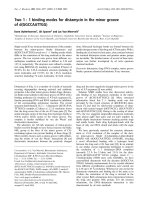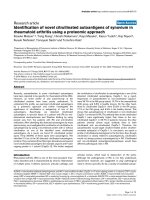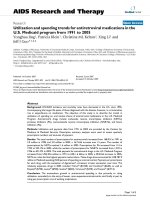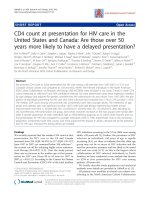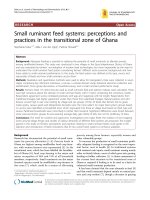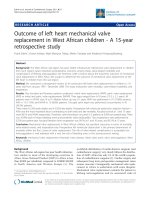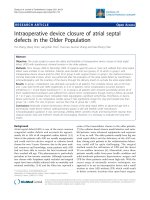Báo cáo y học: " Borna disease virus (BDV) circulating immunocomplex positivity in addicted patients in the Czech Republic: a prospective cohort analysis" potx
Bạn đang xem bản rút gọn của tài liệu. Xem và tải ngay bản đầy đủ của tài liệu tại đây (320.84 KB, 8 trang )
RESEARC H ARTIC LE Open Access
Borna disease virus (BDV) circulating
immunocomplex positivity in addicted patients in
the Czech Republic: a prospective cohort analysis
Sylva Rackova
1*
, Lubos Janu
1
, Hana Kabickova
2
Abstract
Background: Borna disease virus (BDV) is an RNA virus belonging to the family Bornaviridae. Borna disea se virus is
a neurotropic virus that causes changes in mood, behaviour and cognition. BDV causes persistent infection of the
central nervous system. Immune changes lead to activation of infection. Alcohol and drug dependence are
associated with immune impairment.
Methods: We examined the seropositivity of BDV circulating immunocomplexes (CIC) in patients with alcohol and
drug dependence and heal thy individuals (blood donors). We examined 41 addicted patients for the presence of
BDV CIC in the serum by ELISA at the beginning of detoxification, and after eight weeks of abstinence. This is the
first such study performed in patients with alcohol and drug dependence.
Results: BDV CIC positivity was detected in 36.59% of addicted patients on day 0 and in 42.86% on day 56. The
control group was 37.3% positive. However, we did not detect higher BDV CIC positivity in addicted patients in
comparison with blood donors (p = 0.179). The significantly higher level of BDV CIC was associated with lower
levels of GGT (gamma glutamyl transferase) (p = 0.027) and approached statistical significance with the lower age
of addicted patients (p = 0.064). We did not find any association between BDV CIC positivity and other anamnestic
and demographic characteristics.
Conclusions: In our study addicted patients did not have significantly higher levels of BDV CIC than the control
group. The highest levels of BDV CIC were detected in patients with lower levels of GGT and a lower age.
Trial registration: This study was approved by the ethical committee of the University Hospital Med ical Faculty of
Charles University in Pilsen, Czech Republic (registration number 303/2001).
Background
Psychiatric disorders are a wide group of various dis-
eases with heterogeneous etiologies (genetic predisposi-
tion, exposure to stress, environmental factors). It has
been suggested that some zoonotic infections can influ-
ence the course of psychiatric disorders, especially Toxo-
plasma gondii, Borrelia burgdorferi and Borna disease
virus (BDV). Borna disease virus (BDV) is an RNA virus
belonging to the family Bornaviridae, order Mononega-
virales. Borna disease virus affects the central nervous
system (CNS), especially limbic structures, and causes
infection in animals, including humans and birds. The
symptomatology in animals ranges from mild, subclini-
cal infection to lethal meningoencephalitis. This viral
infection is associated with neurological, behavioural,
mood and cognitive changes [1].
Borna disease virus can cause persistent infection of
the CNS. Persistent viral infection is characterised as
those circumstances in which the virus is not cleared
but remains in the cells of infected individuals. There
are three types of persistent viral infection: latent,
chronic and slow infection [2]. The latent type of persis-
tent infection is typical for BDV. Latent infection is
associated with a lack of demonstrable viral particles.
The reactivation of persistent latent BDV infection can
be triggered by several stimuli: immune changes
* Correspondence:
1
Psychiatric Department, University Hospital, Medical Faculty Charles
University in Pilsen, Alej svobody 80, Pilsen, 301 00, Czech Republic
Full list of author information is available at the end of the article
Rackova et al. BMC Psychiatry 2010, 10:70
/>© 2010 Rackova et al; licensee BioMed Central Ltd. This is an Open Access article distribut ed under the terms of the Creative Co mmons
Attribu tion License (h ttp://creativecommons.org/licenses/by/2.0), which permits unrestricted use, distribution, and reproduction in
any medium, provided the original work is prope rly cite d.
(immunosuppression), stress factors, superinfection by
other viruses or trauma [1-3].
Borna disease virus infecti on antigens (Ag), antibodies
(Ab), circulating immunocomplexes (CIC) and RNA can
be isolated from the brain tissue, cerebrospinal fluid and
serum. After activation of latent BDV infection it is pos-
sible to detect Ag. In the second phase of acute viremia,
Ag binds with Ab and forms CIC. Originally for diag-
nostics of BDV infection were used detection o f viral
Ab. The positive finding of BDV Ab means that the
organism has been in contact with BDV but it does not
necessarily imply an active BDV infection [4,5].
Borna disease virus is transmitted between humans,
animals and humans and animals by infected saliva or
other secretions through the nasal mucosa. It spreads
intra-axonally and trans-synaptically towards olphactoric
structures and then to the limbic system. During later
infection, BDV diffuses throughout the CNS and can be
detected in the peripheral nervous system (astrocytes,
Schwann cells, oligodendrocytes).
Borna disease virus causes several changes in brain
functions resulting in mood, behaviour, cognitive and
neurologic disturbances including movement impair-
ment. During infection, BDV influences the CNS in
several ways: firstly a direct influence through binding
of viral proteins with neurotransmitter receptors, and
secondly an indirect influence through immune
response and inflammatory reactions. Both types of
mechanisms influence neurotransmission and lead to
mood, behaviour and emotional changes in infected
individuals and may be associated with human psychia-
tric disorders (affective disorders, addictions and psy-
chotic disorders). The severity of clinical symptoms of
BDV infection depends on the immune response of the
host [3,6-8].
Viral infections can influence the human genome. The
part of human genetic material originates from viruses
and viral sequences assimilate into the host (human)
genome. After infection BDV sequenc es are in tegrated
into the genome of brain cells. These sequences are not
heritable but can cause mutations which interfere with
brain functions and can contribute to the development
of psychiatric disorders [9].
Borna disease virus affects dopaminergic neurotrans-
mission in the central nervous system. These changes
support the possibility of a link between BDV infection
and human neuropsychiatric disorders which are con-
nected with the impairment of the dopaminergic system,
such as schizophrenia, addictions and extrapyramidal
disorders [10].
An increased rate o f BDV infection occurs in psychia-
tric patients (with diagnoses of depression, bipolar affec-
tive disorder and schizophrenia) [3-5] and
immunocompromised patients, especially those with
cellular immunosuppression (including HIV-infected
patients) [11].
Borna disease v irus positivity in psychiatric patient s
ranges from negative to highly positive (about 90-100%).
These differences can be caused by variances in labora-
tory methods, biological materials, psychiatric diagnosis
and the severity of psychopathology in patients and geo-
graphical regions.
Detection of BDV antibodies was first achieved by
Rott and colleagues in psychiatric patients in 1985 using
an IFA method (immunofluorescence assay). There was
a demonstrated BDV Ab positivity in 1-4% of psychiatric
patients and in 20% of acutely depressed patients
[5,12,13]. A higher BDV positivity based on the detec-
tion of viral Ag and CIC has been found in psychiatric
patients (between 50% and 90% positivity) compared
with healthy individual s (between 20% and 30%) by
using the ELISA method. The strength and duration of
BDV CIC positivity correlated with the severity of symp-
toms (higher amounts of BDV CIC and Ag w ere
detected in patients with severe psychopathology in
comparison with lower levels in patients with mild
symptoms) [4,5]. Seve ral studies failed to detect BDV in
psychiatric patients and did not confirm the higher posi-
tivity [14-18]. It is supposed that BDV infection can
modulate the course of psychiatric disorders and play a
role in their pathogenesis.
Alcohol and drug abuse alters dopamin ergic, seroto-
nergic and nonmonoaminergic systems which lead to
mood and behavioural changes [19,20]. Alcohol and
drug abusers have an impaired immune system and this
impairment is manifested in several ways, including an
increased susceptibility to bacterial and viral infections
[21-23].
We hypothesised that patients with alcohol a nd drug
dependence would have a higher BDV CIC positivity
than healthy individuals as a result of immune changes
due to chronic abuse. These immune changes lead to
the activation of persistent BDV infection. We expected
a higher BDV CIC positivity at the beginning of detoxi-
fication (at the time of alcohol and drug abuse) and a
reduction after eight weeks of abstinence due to the
recovery of the immune system and somatic status.
Our study was approved by the ethical committee of
the Universit y Hospital Medical Faculty of Charles Uni-
versity in Pilsen, Czech Republic (registration number
303/2001). The aim and procedures were explained and
informed consent was obtained from all participants.
Methods
Study population
We examined two groups: patients with alcohol and
drug dependence and a control group of healthy indivi-
duals (blood donor s). Patients included in the stud y
Rackova et al. BMC Psychiatry 2010, 10:70
/>Page 2 of 8
fulfilled the following criteria: 1) the patients were hos-
pitalised in the detoxification unit of the Psychiatric
Department of the University Hospital in Pilsen in the
Czech Republic and continued short-term treatment of
addiction for eight weeks between 2007 and 2008; 2) the
patients had a diagnosis of alcohol or drug dependen ce
acco rding to ICD-10 (International Statistical Classifica-
tion of Diseases); 3) the patients were aged 18 years or
older; 4) the patients taking immunosupressiv e drugs or
treated with che motheraphy and ac tinotheraphy were
excluded from the study. We included 41 patients (18
males, 23 females) of whom 22 had alcohol depe ndence
and 19 had drug dependence, aged from 19 to 62 years
(average age 36.29 +/- 12.06 years, median 35 years).
For the control group w e examined blood donors
(n = 126, 97 males, 29 females, aged from 25 to
65 years, average age 40.31 +/- 11.32 years, median
37 years) from the blood bank of the Central Military
Hospital in Prague.
Laboratory methods
Four millil itres of venous blood was t aken from all par-
ticipants (patients and blood donors). The sera were
separated by centrifugation of fresh venous blood within
6 hours after venipuncture. Serum samples were frozen
and stored at -80°C until analysed.
TheBDV-specificCICintheseraofpatientsand
blood donors were determined by EIA (enzyme immuno
ass ay) using a washing apparatus (MRW Dynex) and an
ELISA reader (MUREX MRX). The laboratory method
for BDV CIC detection was developed by Bode and Lud-
wig and uses specific monoclonal antibodies to trap the
antigen part of the CIC [4]. The author s of this method
provided the monoclonal antibodies W1 and Kfu2 for
our study. The antibody part of the CIC was visualised
using an enzyme reaction (alkaline phosphatase) (Figure
1). This method was semi-quantitative. Serum samples
with a reciprocal titre of 20 (cut off titre 1/20) or more
were taken as positive. The levels of BDV CIC were
scored as: 0 negative, + low positivity, ++ mean positiv-
ity, +++ and ++++ high positivity.
Study design
All patients were examined for BDV CIC positivity at
the beginning of detoxification (day 0) and after an
eight-week period of abstinence (day 56). At the same
time standard screening laboratory tests (blood tests,
liv er enzymes, hepatitis A, B and C, tuberculosis, syphi-
lis, human immunodeficiency virus (HIV)) were per-
formed to evaluate the patients’ somatic status.
Laboratory tests for BDV CIC positivity and liver
enzymes were performed on days 0 and 56. A period of
8 weeks is sufficient for the detection of possible
changes in levels of BDV CIC and in the values of liver
enzymes (especially GGT).
Anamnestic and demographic data (age, gender, psy-
chiatric family history including addictions, personal his-
tory of somatic and infectious diseases such as hepatitis
and other zoonosis), the durationofabuse(inyears),
the presence of infecti on at the time of blood sampling,
the diagnosis according to ICD-10 and contact with ani-
mals (breeding, farming, pets) were obt ained from
patients and medical record examination.
Statistical analysis
Both groups were compared according to age and gen-
der using the Wilcoxon rank-sum test, contigency tables
and the chi-square test. The non-parametric Spearman’s
rank and Kendall tests were used to test for interdepen-
dence between variables and the Wilcoxon test was
used to compare mean values. Contingency tables and
the chi-square test were used in cases where there was a
small number of values for the data.
Results
We examined 41 patients on day 0 and 28 patients on
day 56; 13 (31.7%) patients finished their treatment pre-
maturely. The detoxification of addicted patients is often
prematurely ended because of eroded abstinence or
other treatment regimes. The characteristics of addicted
patients are illustrated in Tables 1 and 2.
Age differences between the addicted patients and the
control group were statistically significant (p = 0.048,
the Wilcoxon rank-sum test). The groups also differed
significantly in gender (contingency tables, the chi-
square test). No association between BDV CIC positivity
and gender was demonstrated (p = 0.884, contingency
tables, chi-square test). The difference in BDV CIC posi-
tivity was adjusted for age and gender and was not sta-
tistically significant (age p = 0.302, gender p = 0.498,
higher order contingency tables, the chi-square test).
A BDV CIC positivity was detected in 36. 6% of
patients (15/41) on day 0 and in 42.9% (12/28) patients
after eight weeks of abstinence (day 56) in comparison
with a BDV CIC positivity of 37.3% (47/126) in the con-
trol group (Table 3). The difference in BDV CIC levels
in the serum between these two groups was not statisti-
cally significant on day 0 (p = 0.179, contingency tables,
the chi-square test) or day 56 (p = 0.223, contingency
tables, the chi-square test). There was no reduction in
BDV CIC levels over the abstinence period (p = 0.779,
contingency tables, goodness of fit te st, the chi -square
test).
We monitored changes in BDV CIC levels during the
study on days 0 and 56. For patients who provided both
blood samples:
Rackova et al. BMC Psychiatry 2010, 10:70
/>Page 3 of 8
• in three patients we detected a decrease in BDV
CIC l evels (two patients were BDV CIC positive o n
day 0 and became negative on day 56, one patient’s
positivity decreased from mean (++) to low (+));
• in six BDV CIC-positive patients we found no
change in BDV CIC levels; and
• in five patients we determined an increase of BDV
CIC levels (four patients were BDV CIC negative on
day 0 and became positive on day 56).
We looked at the association of BDV CIC positivity
and other anamnestic and demographic characteristics:
• twenty-two (53.7%) enrolled patients had a positive
psychiatric family history;
• five (12.2%) had a positive his tory of infectious dis-
eases (hepatitis C);
• infection at the time of blood sampling was present
in five (12.2%) patients on day 0 and in two (7.1%)
patients on day 56 (the presence of another infection
can increase the risk of reac tivation of late nt BDV
infection); and
• thirty-seven (90.2%) patients had pets or other ani-
mals (animals can be a reservoir of BDV infection
and contact with inf ected animals increases the risk
of BDV infection transmission).
We did not establish any other significant association
of BDV infection with other anamnestic and demo-
graphic data based on contingency tables, the chi-square
test and the Kruskal Wallis test on days 0 and 56:
• gender (day 0 p = 0.706, day 56 p = 0.045);
• psychiatric family history (day 0 p = 0.713, day 56
p = 0.241);
Figure 1 Detection of BDV circulating immunocomplexes ( CIC) in serum . a) The antibody against mice IgG (against its F c fragment) i s
bound at the surface of the microtitrate plate; b) Mice monoclonal antibody against BDV antigens p40 a p24 is added; c) Patient serum is
added (in which we are detecting CIC, ie. the complex of BDV antigen and human IgG); d) Goat antihuman IgG (against its Fc fragmen)
conjugated with enzyme (ALP - alcaline phosphatase) is added; e) Substrate of ALP p-nitrophenylphosphate (pNPP) is added; pNPP is hydrolysed
by ALP and released p-nitrophenol (pNP) has intensive yellow colour, which is detected by spectrophotometry using microtitrate plate reader
(wave length 405 nm).
Table 1 Characteristics of addicted patients
Characteristics Range Average Median
Age (years) 19-62 36.29 +/- 12.06 35.0
Duration of abuse (years) 2-15 6.32 +/- 3.60 5.0
GGT day 0 (ukat/l) 0.18-23.07 3.21 +/- 5.586 0.59
GGT day 56 (ukat/l) 0.11-3.13 0.682 +/- 0.755 0.345
Table 2 Diagnosis of addicted patients according to ICD-
10
Diagnosis No. of
patients (%)
No. of
females
No. of
males
F 10.2 alcohol dependence 24 (58.5) 14 10
F 11.2 heroin dependence 3 (7.3) 0 3
F 13.2 benzodiazepine
dependence
2 (4.9) 2 0
F 15.2 metamphetamine
dependence
12 (29.3) 7 5
Rackova et al. BMC Psychiatry 2010, 10:70
/>Page 4 of 8
• personal history of infectious diseases (day 0
p = 0.692, day 56 p = 0.813);
• presence of infection at the time of sampling (day
0 p = 0.825, day 56 p = 0.452);
• duration of abuse ( day 0 p = 0. 918, day 56
p = 0.436);
• diagnosis according to ICD-10 (day 0 p = 0.468,
day 56 p = 0.557); and
• contact with animals (day 0 p = 0.611, day 56
p = 0.446).
A higher BDV CIC positivity was significantly asso-
ciated with lower levels of GGT (gamma-glutamyl
transferase) at the beginning of detoxification (p =
0.027, rank cor relation with the Kruskal Wallis test)
and approached statistical significance with the
lower a ge of addicted patients (p = 0.064, rank cor-
relation with the Kruskal Wallis test).
We proved no association between BDV CIC positivity
on day 0 and premature ending of the treatment. Pre-
mature ending of the treat ment was not associated with
BDV CIC positivity on day 0 (p = 0.645, contingency
tables, the chi-square test).
Discussion
In this study the positivity of BDV CIC was detected in
36.6% of addicted patients at the beginning of detoxifi-
cation, in 42.9% after eight weeks of abstinence and in
37.3% of the control group of blood donors.
Surprisingly, we did not find a higher BDV CIC positiv-
ity in patients with alcohol and drug dependence in com-
parison with healthy individuals. Nor did we find any
significant difference between BDV CIC positivity at the
beginning of detoxification and after eight weeks of absti-
nence. A BDV CIC positivity was not associated with the
premature ending of treatment. We cannot compare our
results with other studies because no other studies of
BDV infection in addicted patients have been published.
Larger studies are needed to confirm these results.
We assumed a higher positivity of BDV infection in
addicted patients because of the higher BDV CIC
positivity found in psychiatric patients in the Czech
Republic, and possible changes in immunity and close
relationships with e ndemic regions for BDV in central
Europe. T he positivity of BDV CIC in addicted patients
in the present study was lower than that found in our
previous study in psychiatric patients (with psychotic
and affective disorders). We detected BDV CIC positiv-
ity in 66.7% of psychiatric patients and the intensity of
BDV infection was positively correlated with psycho-
pathology [24].
Bode and colleagues detected a BDV CIC positivity of
between 40% and 50% in psychiatric patients and
between 90% and 100% in patients with an acute state
of affective disorders in comparison with a positivity of
30% in blood do nors. The persistence of high amounts
of plasma BDV CIC and Ag correlated with the sever ity
of depression [4].
Nunes and colleagues examined BDV RNA by using
reverse transcriptase polymerase chain reaction in psy-
chiatric patients, their relatives and healthy controls.
Borna disea se virus RNA posi tivity was det ected in
patients with psychotic disorders (44.4%), relatives with-
out mental disorders (50%), relatives with mental disor-
ders (37.5%) and healthy controls (14.8%) [25].
Another study failed to detect BDV positivity in psy-
chiatric patients (depression, bipolar disorders, schizo-
phrenia) where neither theBDVantibodynortheBDV
RNA was proven in psychiatric pat ients or healthy con-
trols [18]. The authors of this study suggested that BDV
infection might not be associated with mental disorders
in this region.
We examined the presence of BDV CIC in the serum
by using the ELISA method and were able to detect
active BDV infection. The ELISA method finds a higher
BDV positivity than other laboratory methods (IFA)
[4,5].
Borna disease virus infection (antibodies) was first
detected using serological methods, especially immuno-
fluorescence (IFA), by Rott and colleagues [13]. A posi-
tivity of BDV Ab was found of between 1% and 4%.
Another laboratory method which has been used for the
Table 3 Levels of BDV CIC in addicted patients on day 0 and 56 and in blood donors
Psychiatric patients Blood donors
Level of BDV CIC Day 0 (n = 41) Day 56 (n = 28) (n = 126)
No. (%) No. of females No. of males No. (%) No. of females No. of males No. (%) No. of females No. of males
Positive 15 (36.6) 8 7 12 (42.9) 6 6 47 (37.3) 10 37
+ (low) 11 (26.8) 6 5 9 (32.1) 3 6 44 (34.9) 9 35
++ (mean) 3 (7.3) 1 2 3 (10.7) 3 0 3 (2.4) 1 2
+++ (high) 0 0 0 0 0 0 0 0 0
++++ (high) 1 (2.4) 1 0 0 0 0 0 0 0
Negative 26 (63.4) 15 11 16 (57.1) 12 4 79 (62.7) 19 60
Rackova et al. BMC Psychiatry 2010, 10:70
/>Page 5 of 8
detection of BDV Ab is western blot (WB). These meth-
ods detecting only BDV Ab were found to be less sensi-
tive than the ELISA method and were not able to detect
acute phases of BDV infection. Antibodies, when found
alone, can indicate a previous contact with BDV but not
an acute state. Bode and colleagues examined plasma
samples using ELISA for BDV CIC positivity and immu-
nofluorescence for the detection of antibodies. The BDV
CIC determination found a higher prevalence of infec-
tion than previous IFA methods (ten times higher infec-
tion rates) [4,26].
Antigenaemia indicates an acute and productive phase
of infection. During this phase of BDV inf ection antibo-
dies bind to the antigens and form circulating immuno-
complexes (CIC), which are measurable for weeks or
months. The frequency and stability of BDV CIC makes
them available screening markers of BDV infection, as
recommended by some authors. By using the ELISA
method it is possible to detect viral Ag in plasma. A
higher positivity of BDV Ag was detected in patients
with depression and the intensity and duration of anti-
genaemia was correlated with the severity of symptoms
[4,5]. The disadvantage of this detection method is the
very short period of antigaenemia in the acute phase of
BDV infection [4,5,26].
Several authors used the detection of viral RNA in
PBMCs (peripheral blood mononuclear cells) or brain
tissue by polymerase chain reaction (PCR) for the diag-
nosis of BDV infection. However, other researchers did
not use this method for the diagnosis of BDV infection
because of the possibility of sample contamination dur-
ing the laboratory procedures [26], although this con-
tamination should not occur when the detection of BDV
RNA is performed according to international security
instructions [25]. The absence of BDV RNA in the
serum cannot exclude the presence of infection as the
low a mount of RNA is not possible to detect using t his
method. The second reason for not using B DV RNA
detection is that that the presence of BDV RNA does
not reflect an active state of viral replication [26].
A limitation of our study was that only BDV CIC
positivity was detected. Antigens and circulating immu-
nocomplexes are the markers of BDV infection activity.
Some CIC-negative patients can have acute viraemia
and are only Ag positive. Furthermore, the immune
impairment in addicted patients lowers the ability to
produce Ab and provides far less CIC formation. Also,
immune changes in a ddicts are not important for BDV
infection.
We found a higher BDV CIC positivity in younger
patients and a decrease in BDV CIC positivity with the
increasing age of patients. This finding is consistent
with the observations of the Polish psychiatric popula-
tion [27] and German [28] and Italian [29,30] studies
which demonstrated a significantly higher BDV CIC
positivity in children. Patti and colleagues investigated
BDV positivity in children in Italy. A BDV CIC positivity
was found in 57%. The prevalence of BDV infection was
found to be higher in children, particularly in the third
year of life, then, it decreased until 15 years of age,
where another increase was observ ed [29,30]. Scholbach
and colleagues demonstrated a higher BDV Ag and CIC
positivity in children. There were two age intervals of
peak BDV positivity, the first with a peak at 6 months
old and the second with a peak value around 2-3 years
old. These findings s upported the possibility of vertical
transmission of BDV infection. Also, children of 2-3
years old are likely to be in more intensive contact with
the secretions of animals, which a re associated with a
greater possibility of BDV transmission in children than
in adults [28].
Flower and colleagues found a positive association
between BDV positivity and elevated liver enzymes.
They described the association between BDV antigenae-
mia and elev ated plasma levels of A LT and GGT in
multi-transfused patients. It was not clearly explained
whether these findi ngs had any causal association s [31].
In our study we detected the opposite situation, where a
higher BDV CIC positivity was significantly associated
with a lower level of GGT, implying milder liver imp air-
ment. We are not able to satisfactorily explain this find-
ing yet. The influence of a lower age (i.e. a shorter
history of abuse and/or higher frequency of non-alco-
holic drug abuse) was not confirmed.
Alcohol and drug abuse interferes with humoral and
cellular immunity and leads to the suppression of
human resistance to bacterial and viral infections,
increasing infection susceptibility. This direct influence
on immunity in combination with other risk factors
(risk behaviour, vitamine deficiency) is associated with
impairment of the immune system [22,23].
We proved no significant association between BDV
CIC positivity and the history of infectious diseases
(hepatitis C) or the presence of infection at the time
of blood sampling. The presence of other infections
can reactivate the latent BDV infection and cause the
increase of BDV positivity [2,3]. Cotto and colleagues
investigated the presence of BDV infection (BDV
RNA) in two groups of immunocompromised patients
(with HIV infection and treated with immunosuppres-
sive medication). They detected a significantly higher
BDV positivity in patients with HIV infection com-
paredwiththesecondgroupandhealthycontrols
[11].
In our study, contact with animals was not associated
with BDV CIC positivity, although the majority of the
addicted patients from our study had been exposed to
animals (especially pets such as dogs and cats).
Rackova et al. BMC Psychiatry 2010, 10:70
/>Page 6 of 8
Some studies described a higher BDV positivity in
people who were in contact with infected animals.
Weisman and colleagues reported a significantly higher
positivity of BDV antibodies (46%) in workers exposed
to infected ostriches versus a BDV positivity of 10% in
controls. There was a strong correlation between the
intensity of exposure and the rate of seropositivity
[32]. Takahashi and colleagues found a significantly
higher seropositivity of BDV (from 2.6% to 14.8%) in
blood donors from regions where horse farms were
concentrat ed compared with a BDV positivity of 1% in
blood donors from other regions [33]. These findings
support the possible animal-to-human transmission of
BDV infection. In contrast, another study from Bangla-
desh did not confirm this hypothesis. The authors sur-
veyed horses and their caretakers for BDV antibody
positivity and found a BDV positivity of between 25-
30% in the horses but none of caretakers were positive
for BDV [34]. Thomas and colleagues reported that
people working or living on livestock farms had a
higher BDV seroprevalence compared with other
farms. Exposure to animals did not increase the risk of
BDV positivity [ 35].
Another explanation for not finding an a ssociation
between contact with animals and BDV CIC positivity is
that these results might have been derived from an area
in wh ich the BDV infection o f animals is not endemic.
We still have no data about the prevalence of BDV
infection in animals in the Czech Republic. Several stu-
dies found a high BDV positivity in horses and sheep
[1,36] and a lower BDV positivity in other species (dogs,
cats, cattle) [1]. Addicted patients from o ur study were
frequently exposed to pets such as cats and dogs
(90.2%) but they were not exposed to farm animals,
which we could expect to have a higher BDV positivity
than pets.
Conclusions
This study compared B DV CIC positivity in addicted
patients and healthy individuals. We detected no signifi-
cant difference in BDV positivity between these two
groups and betwe en BDV p ositivity on days 0 and 56.
We found an association between BDV infection and
the levels of GGT and the ag e of the patient. Additional
studies will continue to examine BDV CIC and Ag in
psychiatric inpatients and addicted patients.
List of abbreviatio ns
Ag: antigen; Ab: antibody; BDV: Borna disease virus;
CIC: circulating immunocomplexes; CNS: central ner-
vous system; GGT: gamma-glutamyl transferase; HIV:
human immunodeficiency virus; EIA: enzyme immu-
noassay; ELISA: enzyme-linked immunosorbent assay;
IFA: immunofluorescence assay; ICD-10: International
Statistical Classification of Diseases; PCR: polymerase
chain reaction; RNA: ribonucleic acid;
Acknowledgements
The authors thank for the support Liv Bode (Robert Koch Institute, Berlin,
Germany) and Hanns Ludwig (Free University of Berlin, Germany), who
developed the enzyme immuno assay-CIC assay for the detection of BDV
CIC and allowed us to use this test for the detection of BDV CIC in our
study in the Czech Republic. The authors also thank František Sefrna
(University Hospital, Medical Faculty, Charles University in Pilsen), who
performed the statistical analyses. The authors of this study did not receive
any financial support. Proof-reading of the manuscript was provided by
Proof-Reading-Service.com.
Author details
1
Psychiatric Department, University Hospital, Medical Faculty Charles
University in Pilsen, Alej svobody 80, Pilsen, 301 00, Czech Republic.
2
Klinlab
s.r.o, Department of Molecular Biology and Parasitology, U Vojenské
nemocnice 1200, Prague, 100 00, Czech Republic.
Authors’ contributions
SR designed the study protocol, obtained the approval of the local ethical
committee, wrote the manuscript, performed the clinical evaluation of
psychiatric patients and performed the evaluation of psychiatric patients
with psychiatric scales and anamnestic questionnaires and the blood
sampling for the BDV CIC examination.
LJ designed the study protocol, wrote the manuscript and performed the
clinical evaluation of psychiatric patients and the evaluation of psychiatri c
patients with psychiatric scales and anamnestic questionnaires.
HK performed the laboratory tests on blood samples from psychiatric
patients and blood donors for BDV CIC positivity.
All authors read and approved the final manuscript.
Competing interests
The authors declare that they have no competing interests.
Received: 28 September 2009 Accepted: 8 September 2010
Published: 8 September 2010
References
1. Ludwig H, Bode L: Borna disease virus: new aspects on infection, disease,
diagnosis and epidemiology. Rev Sci Tech Off Int Epiz 2000, 19(1):259-288.
2. Boldogh I, Albrecht T, Porter DD, Baron S, Peské RC, James DA, Susman M,
Kennedy CA, Singleton MJD, Schuenke S: Persistent Viral Infections. In
Medical Microbiology. Edited by: Samuel Baron. The University of Texas:
Medical Branch at Galveston; 1996:.
3. Dietrich DE, Schedlowski M, Bode L, Ludwig H, Emrich HM: A viro-psycho-
immunological disease-model of a subtype affective disorder.
Pharmacopsychiatry 1998, 31:77-82.
4. Bode L, Reckwald P, Severu WE, Stoyloff R, Ferszt R, Ditrich DE, Ludwig H:
Borna disease virus-specific circulating immune complexes,
antigenaemia, and free antibodies - the key marker triplet determining
infection and prevailing in severe mood disorders. Mol Psychiatry 2001,
6(4):481-491.
5. Bode L, Ludwig H: Borna disease virus infection, a human mental-health
risk. Clin Microbiol Rev 2003, 16(3):534-545.
6. Solbrig M, Koob V, George F: Neuropharmacological sequelae of
persistent CNS viral infections: lessons from Borna disease virus.
Pharmacol Biochem Nebav 2003, 74(4):777-787.
7. Stitz L, Noske K, Planz O, Furrer E, Lipkin WI, Bilzer T: A functional role for
neutralizing antibodies in Borna disease: influence of virus tropism
outside the central nervous system. J Virol 1998, 72(11):8884-8892.
8. Volmer R, Prat ChMA, Masson G, Garenne A, Gonzales-Dunia D: Borna
disease virus infection impairs synaptic plasticity. J Virol 2007,
81(16):8833-8837.
9. Feschotte C: Borna virus enters the genome. Nature 2010, 463:39-40.
10. Solbrig MV: Animal models of CNS viral disease: Examples from Borna
disease virus models. Interdisciplinary Perspectives on Infectious Diseases
2010, 2010:1-6.
Rackova et al. BMC Psychiatry 2010, 10:70
/>Page 7 of 8
11. Cotto E, Neau D, Cransac-Neau M, Auriacombe M, Pellegrin JL, Ragnaud JM,
Fillet AM, Belnard M, Fleury H, Lafon ME: Borna disease virus RNA in
immunocompromised patients in southwestern France. J Clin Microbiol
2003, 41(12):5577-5581.
12. Bode L, Durrwald R, Rantam FA, Ferszt R, Ludwig H: First isolates of
infectious human Borna disease virus from patients with mood
disorders. Mol Psychiatry 1996, 1:200-212.
13. Rott R, Herzog S, Fleischer B, Winokur A, Amsterdam J, Dyson W,
Koprowski H: Detection of serum antibodies to Borna disease virus in
patients with psychiatric disorders. Science 1985, 228(4700):755-756.
14. Chalmers RM, Thomas DR, Salmon RL: Borna disease virus and the
evidence for human pathogenicity: a systematic review. QJMed2005,
98:255-274.
15. Fukuda K, Takahashi K, Iwata Y, Mori N, Gonda K, Ogawa T, Osonoe K,
Sato M, Ogata S, Horimoto T, Sawada T, Tashiro M, Yamaguchi K, Niwa S,
Shigeta S: Immunological and PCR analyses for Borna disease virus in
psychiatric patients and blood donors in Japan. J Clin Microbiol 2001,
39(2):419-429.
16. Iwata Y, Takahashi K, Peng X, Fukuda K, Ohno K, Ogawa T, Gonda K, Mori N,
Niwa S, Shigeta S: Detection and sequence analysis of Borna disease
virus p24 RNA from peripheral blood mononuclear cells of patients with
mood disorders or schizophrenia and of blood donors. J Virol 1998,
72(12):10044-6.
17. Tsuji K, Toyomasu K, Imamura Y, Maeda H, Toyoda T: No association of
Borna disease virus with psychiatric disorders among patients in
northern Kyushu, Japan. J Med Virol 2000, 61(3):336-340.
18. Na KS, Tae SH, Song JW, Kim YK: Failure to detect Borna disease virus
antibody and RNA from peripheral blood mononuclear cells of
psychiatric patients. Psychiatry Invest 2009, 6:306-312.
19. London ED, Simon SL, Berman SM, Mandelkern MA, Lichtman AM,
Bramen J, Shinn AK, Miotto K, Learn J, Dong Y, Matochik JA, Kurian V,
Newton T, Woods R, Rawson R, Ling W: Mood disturbances and regional
cerebral metabolic abnormalities in recently abstinent metamphetamine
abusers. Arch Gen Psychiatry 2004, 61:73-84.
20. Tomkins DM, Sellers EM: Addiction and the brain: the role of
neurotransmitters in the cause and treatment of drug dependence.
CMAJ 2001, 164(6):817-821.
21. Brown LAS, Cook RT, Jerrells TR, Kolls JK, Nagy LE, Szabo G, Wands JR,
Kovacs EJ: Acute and chronic alcohol abuse modulate immunity. Alcohol
Clin Exp Res 2006, 30(9):1624-1631.
22. Inabo HI: The relationship between drug abuse and microbial infections.
African Journal of Biotechnology 2005, 4(13):1588-1590.
23. Szabo G: Alcohol’s contribution to compromised immunity. Alcohol Health
Res World 1997, 21(1):30-41.
24. Rackova S, Janu L, Kabickova H:
Borna disease virus circulating
immunocomplex positivity and psychopathology in psychiatric patients
in the Czech Republic. Neuroendocrinol Lett 2009, 30(3):414-419.
25. Nunes SO, Itano EN, Amarante MK, Reiche EM, Miranda HC, de Oliveria CE,
Matsuo T, Vargas HO, Watanabe MA: RNA from Borna disease virus in
patients with schizophrenia schizoaffective disorders and their biological
relatives. J Clin Lab Anal 2008, 22:314-320.
26. Thakur R, Sarma S, Sharma B: Role of Borna disease virus in
neuropsychiatric illnesses: are we inching closer? Indian J Med Microbiol
2009, 27(3):191-201.
27. Rybakowski F, Sawada T, Yamaguchi K: Borna disease virus-reactive
antibodies and recent-onset psychiatric disorders. European Psychiatry
2001, 16(3):191-192.
28. Scholbach T, Bode L: Borna disease virus infection in young children.
APMIS 2008, 116(Suppl 124):83-88.
29. Patti AM, Vulcano A, Candelori E, Donfrancesco R, Ludwig H, Bode L: Borna
disease virus infection in Italian children. A potential risk for the
developing brain? APMIS 2008, 116(Suppl 124):70-73.
30. Patti AM, Vulcano A, Candelori E, Travali S: Serological evidence of Borna
disease virus infection in children, cats and horses in Sicily (Italy). APMIS
2008, 116(Suppl 124):77-79.
31. Flower RLP, Kamhieh S, Mclean L, Bode L, Ludwig H, Ward CM: Human
Borna disease virus infection in Australia: Serological markers of
infection in multi-transfused patients. APMIS 2008, 116(Suppl 124):89-93.
32. Weisman Y, Huminer D, Malkinson M, Metr R, Klice S, Lipkin WI, Pitlik S:
Borna disease virus antibodies among workers exposed to infected
ostriches. Lancet 1994, 344:1232-1233.
33. Takahashi H, Nakaya T, Nakanuta Y, Asahi S, Onishi Y, Ikebuchi K,
Takahashi TA, Katoh T, Sekiguchi S, Takazawa M, Tahala H, Ikuta1 K: Higher
Prevalence of Borna Disease Virus Infection in Blood Donors Living Near
Thoroughbred Horse Farms. J Med Virol 1997, 52:330-335.
34. Khan MA, Yamaguchi K, Miytara H, Kazi A, Kamahora T, Hino S: Prevalence
of anti-Borna disease virus antipody in horses and their caretakers in
Bangladesh. Yonago Acta medica 2000, 43:59-67.
35. Thomas DR, Chalmers RM, Crook B, Stagg S, Thomas HV, Lewis G,
Salmon RL, Caul EO, Morgan KL, Coleman TJ, Morgan-Capner P, Sillist M,
Kench SM, Meadows D, Softley P: Borna disease virus and mental health:
a cross-sectional study. QJMed2005, 98:247-254.
36. Pisoni G, Nativi D, Bronzo V, Codazza D: Sero-epidemiological study of
Borna disease virus infection in the Italian equine population. Vet Res
Commun 2007, 31(Suppl 1):245-248.
Pre-publication history
The pre-publication history for this paper can be accessed here:
/>doi:10.1186/1471-244X-10-70
Cite this article as: Rackova et al .: Borna disease virus (BDV) circulating
immunocomplex positivity in addicted patients in the Czech Republic: a
prospective cohort analysis. BMC Psychiatry 2010 10:70.
Submit your next manuscript to BioMed Central
and take full advantage of:
• Convenient online submission
• Thorough peer review
• No space constraints or color figure charges
• Immediate publication on acceptance
• Inclusion in PubMed, CAS, Scopus and Google Scholar
• Research which is freely available for redistribution
Submit your manuscript at
www.biomedcentral.com/submit
Rackova et al. BMC Psychiatry 2010, 10:70
/>Page 8 of 8
